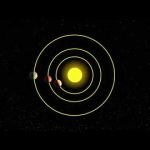Our solar system now is tied for most number of planets around a single star, with the recent discovery of an eighth planet circling Kepler-90, a Sun-like star 2,545 light years from Earth. The planet was discovered in data from NASA’s Kepler space telescope. More info: http://www.nasa.gov/press-release/artificial-intelligence-nasa-data-used-to-discover-eighth-planet-circling-distant-star/index.html
The newly-discovered Kepler-90i — a sizzling hot, rocky planet that orbits its star once every 14.4 days — was found by researchers from Google and The University of Texas at Austin using machine learning. Machine learning is an approach to artificial intelligence in which computers “learn.” In this case, computers learned to identify planets by finding in Kepler data instances where the telescope recorded signals from planets beyond our solar system, known as exoplanets.
Video credit: NASA/Ames Research Center
NASA’s Ames Research Center is located in California’s Silicon Valley. Follow us on social media to hear about the latest developments in space, science and technology.
Facebook
https://www.facebook.com/nasaames/
Twitter
https://twitter.com/NASAAmes
Instagram
https://www.instagram.com/nasaames/
Similar Posts:
-

Machine Learning Tutorial | Machine Learning Basics | Machine Learning Algorithms | Simplilearn -

Machine Learning Basics | What Is Machine Learning? | Introduction To Machine Learning | Simplilearn -

Supervised and Unsupervised Learning In Machine Learning | Machine Learning Tutorial | Simplilearn -

Random Forest Algorithm – Random Forest Explained | Random Forest in Machine Learning | Simplilearn

Leave a Reply